How to use Bibecfo
Your step-by-step guide
Before using your inhaler for the first time or if you have not used an inhaler for 14 days or more, you should test your inhaler to make sure that it is working properly.
Access the patient information leaflet at the bottom of the page for more information.
Use this step-by-step guide to help you remember how to use your Bibecfo inhaler.
Please read the section in your patient information leaflet entitled “testing your inhaler”. Check the dose counter.
If you are testing your inhaler for the first time, the counter should read 120. Whenever possible, stand or sit in an upright position when inhaling.
-
Step 1
Remove the protective cap from the mouthpiece and check that the mouthpiece is clean and free from dust and dirt or any other foreign objects.
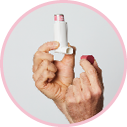
-
Step 2
Breathe out as slowly and deeply as possible.
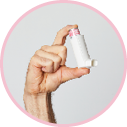
-
Step 3
Hold the canister vertically with its body upwards and put your lips around the mouthpiece.
Do not bite the mouthpiece.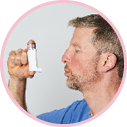
-
Step 4
Breathe in slowly and deeply through your mouth and, just after starting to breathe in press down firmly on the top of the inhaler to release one puff.
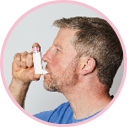
-
Step 5
Hold your breath for as long as possible and, finally, remove the inhaler from your mouth and breathe out slowly. Do not breathe into the inhaler.
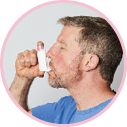
If you need to take another puff, keep the inhaler in the vertical position for about half a minute,
then repeat steps 2 to 5. Do not rush steps 2 to 5.
A guide to the safety of Bibecfo
Like with all medicines, Bibecfo may cause side effects, although not everybody gets them.
When using an inhaler to treat your asthma or COPD symptoms, there is a risk of worsening shortness of breath and wheezing immediately after using Bibecfo – this is known as paradoxical bronchospasm.
If this happens you should STOP using Bibecfo immediately. Use your quick-acting reliever inhaler straightaway to treat your shortness of breath and wheezing, then contact your doctor immediately.
Also talk to your doctor immediately if you experience any hypersensitivity reactions like:
- Skin allergies
- Skin itching
- Skin rash
- Reddening of the skin
- Swelling of the skin or mucous membranes, especially of the eyes, face, lips and throat
Other possible side effects
When taking Bibecfo, it’s helpful to know about potential side effects, so you can recognise and manage them with confidence.
Common side effects which may affect up to 1 in 10 people include:
- Fungal infections (of the mouth and throat)
- Headache
- Hoarseness
- Sore throat
Pneumonia has also been listed as a common side effect in patients prescribed Bibecfo for the treatment of COPD. Tell your doctor if you have any of the following as they could be symptoms of a lung infection:
- Fever or chills
- Increased mucus production, change in mucus colour
- Increased cough or increased breathing difficulties
For more information about side effects, please refer to the patient information leaflet or talk to your doctor, pharmacist, or nurse.
Download your guide
Download an informative guide about living with asthma or COPD and how to use your inhaler.
If you feel unwell or have any problems using your inhaler, you should contact your doctor, nurse or pharmacist. They will be able to answer any questions you may have.

